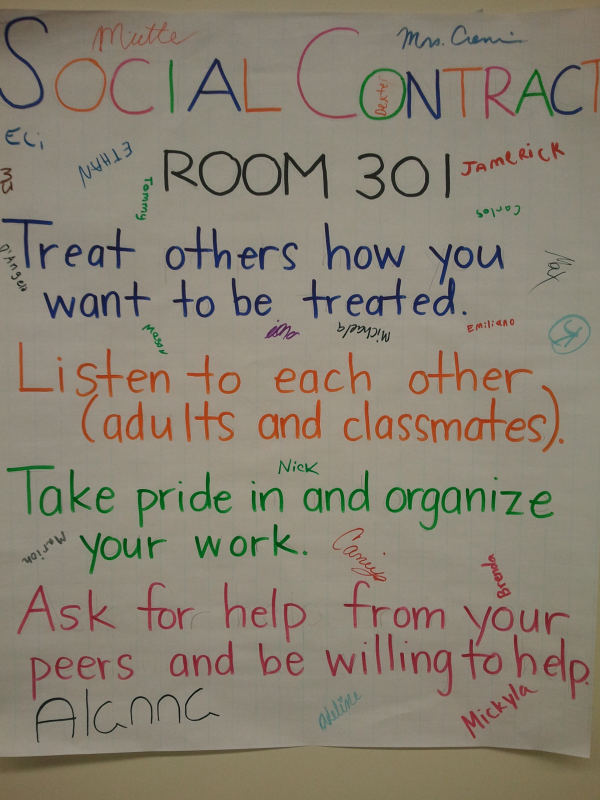By: Lindsey Graff on October 31st, 2013
How I Talk to Students About Bullying Prevention & Awareness – Part II
When I think about bullying prevention month what comes to mind is often some sort of awareness activity – maybe students and staff wear shirts that say, “Stand Up to Bullying,” or red wristbands that represent putting a stop to bullying. These awareness-generating events are important and certainly have their place, but I feel that bullying prevention is a year-long endeavor that revolves around building a safe, caring, classroom community.
 In my middle school classroom of 25 sixth graders, we begin the school year by creating the Room 301 Social Contract. Now, before I go any further, to those of you who groaned when you heard this term, I completely understand. My eyes used to glaze over when I heard the terms social and contract paired together. In the past I’ve created a set of classroom expectations with students just to cross it off of my beginning of the year checklist.
In my middle school classroom of 25 sixth graders, we begin the school year by creating the Room 301 Social Contract. Now, before I go any further, to those of you who groaned when you heard this term, I completely understand. My eyes used to glaze over when I heard the terms social and contract paired together. In the past I’ve created a set of classroom expectations with students just to cross it off of my beginning of the year checklist.
That all changed after I recently attended a training on relationship-based learning in the classroom. Research shows that students who have the skills necessary to build strong relationships are happier, healthier and more successful in school. The basis of this training is on creating a classroom community that focuses on cooperation, communication, responsibility, engagement, empathy and self-control. This same set of classroom values will also greatly diminish, if not eradicate, bullying. The path to developing this ideal classroom begins by creating a social contract with your students.
I start this process by having students work in collaborative groups to generate ideas about what they have liked about their classroom communities in the past. I make sure to guide them to think about how they should interact with each other in a respectful way. It can be helpful to pose this question to students as, “What should the classroom look, sound and feel like in order to make sure everyone has a safe and productive learning environment?”
Students will typically come up with ideas like, “Be quiet when others are working,” and, “Give your best effort.” Once the ideas have started to flow, I have each group record 3-5 ideas on sentence strips. (You can buy these at any school supply store for under $5.) After all of the groups have recorded their ideas, they post them for the class to see and we examine them as a group, looking for similar ideas that can be condensed, and wording that we like.
From here we synthesize the original 20 statements into a more manageable 3-4 guidelines that we can all agree to live with. This becomes the foundation of our Social Contract. The fact that these guidelines grew organically from the students gives them a real sense of ownership in the stake of the classroom. From here on out, all student behavior must be in line with these guidelines. They are transferred to a poster, which is displayed prominently and reviewed frequently throughout the year.
The most meaningful part of the whole process is the contract signing ceremony. We sit in a circle, and one at a time, students come to the center and sign their name on the contract. At this time I pledge to be the manager of this social contract. As the teacher, it is my job to ensure that all students are following the guidelines that we’ve agreed upon as a class.
I will be the first to say that just because an expectation is in place, it doesn’t mean it will be adhered by 100% of the time. But this is where having the social contract comes in so handy! When students are not following the contract, as the classroom manager, I hold a conference with them. During this time we refer back to the rules that they wrote and discuss how their behavior was working against our classroom agreements. We are able to have a productive conversation since students see their signature on the contract and remember back to their participation in the initial drafting of the document.
Forming positive relationships with their peers and teachers is one of the most important things that a student can take away from their adolescent years. If students have developed the skills they need to engage in a caring community within their classroom, they are more likely to transfer these skills into other social situations.
Although this activity is typically done at the beginning of the school year, it is never too late to create a social contract in your classroom. When is the last time you have discussed the classroom expectations with your students? There is no better time than National Bullying Prevention and Awareness Month to create or revisit the social contract in your classroom to ensure that all students are thriving socially and academically.
Want to learn more about how you can create visual aids and activities to foster a culture of bullying prevention in your school? Request a no-obligation demonstration with one of our expert education consultants today to learn more!
Julia Cremin

Julia Cremin is a 6th grade Reading, Language Arts and Math teacher at O'Keeffe Middle School in Madison, WI. She is certified in Elementary Education (grades 1-9) with a minor in Mathematics. This is her third year teaching middle school.

